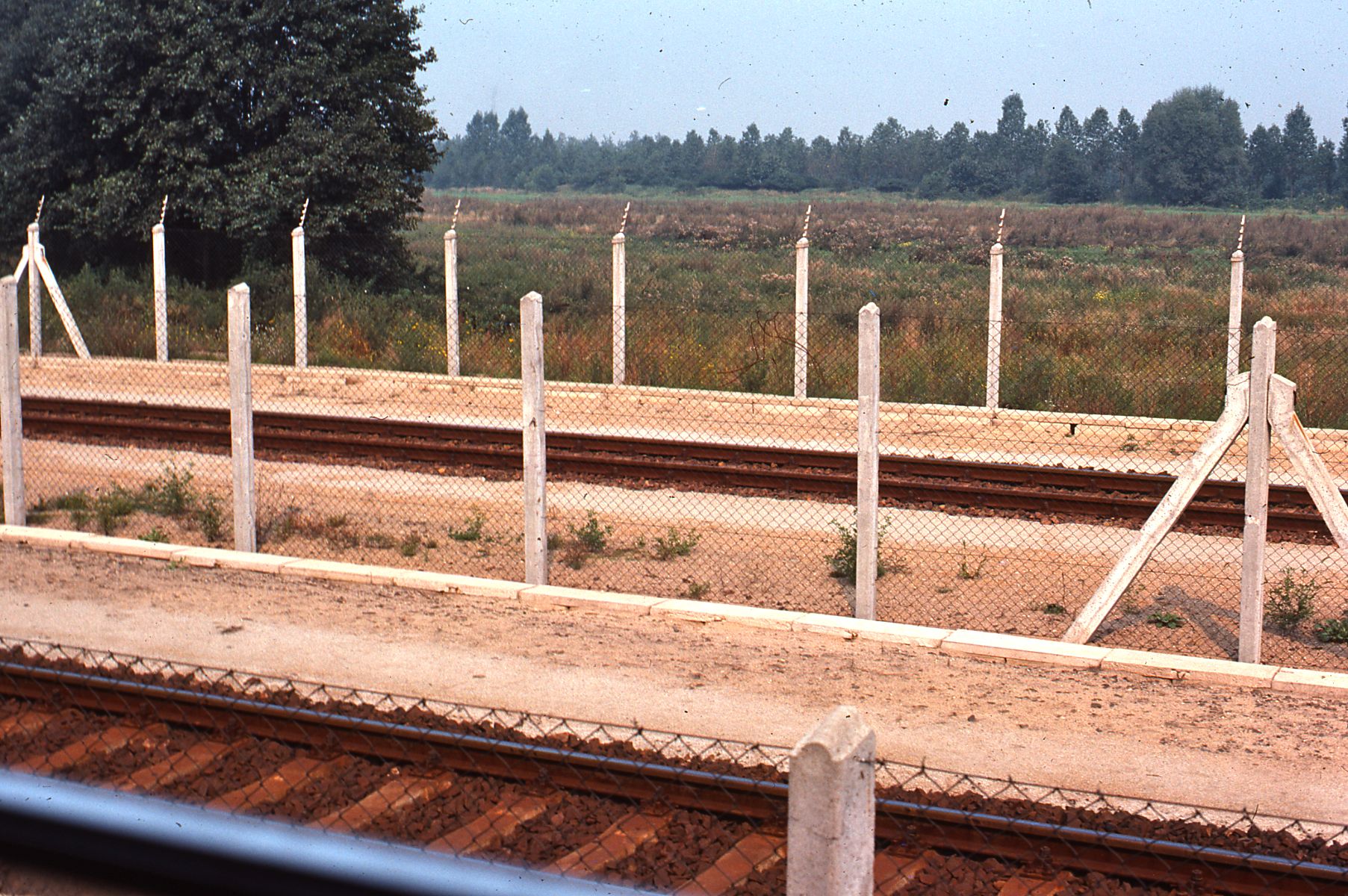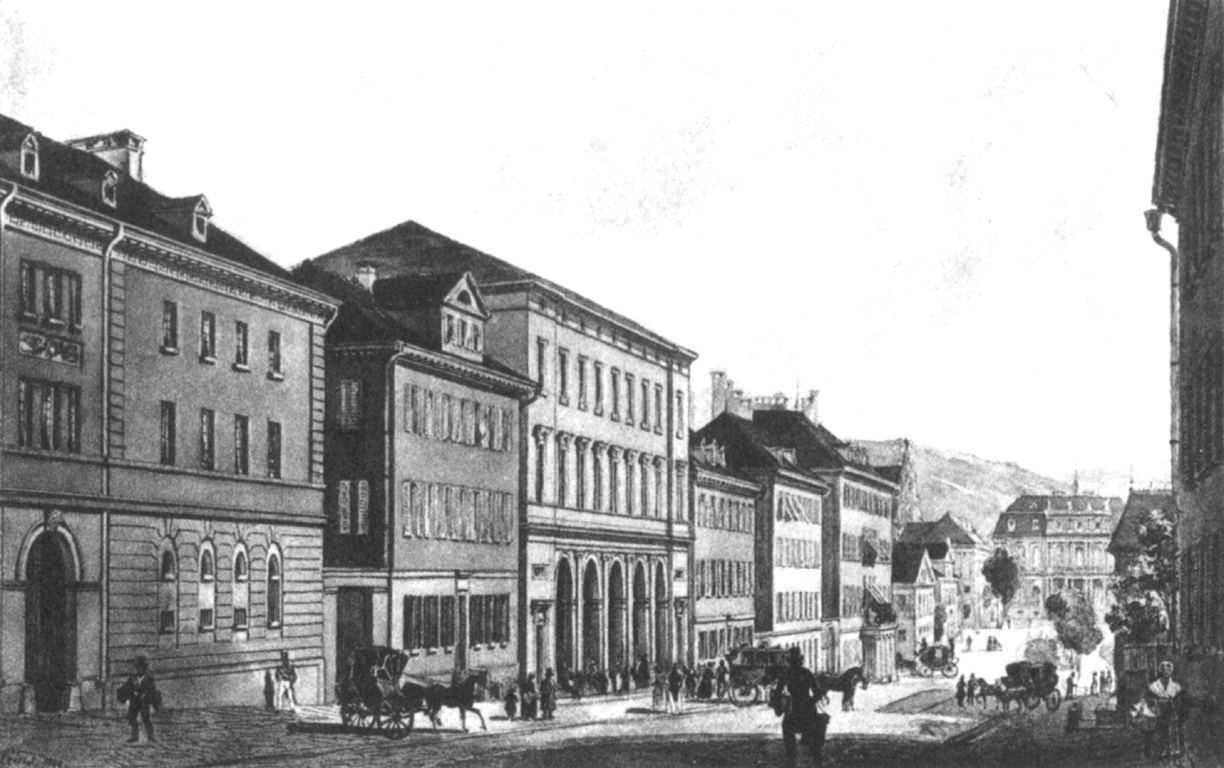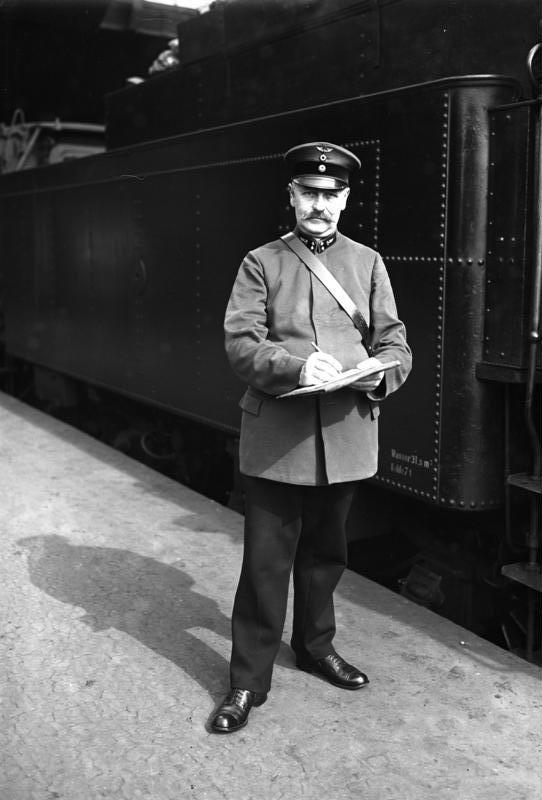|
Weil Der Stadt Station
Weil der Stadt station is a station located at the terminus of the Black Forest Railway in the town of Weil der Stadt in the German state of Baden-Württemberg. The section to Calw is disused. The station is the terminus of line S 6 of the S-Bahn. It is classified by Deutsche Bahn as a category 4 station. History In September 1862, the Royal Württemberg State Railways (german: Königlich Württembergischen Staats-Eisenbahnen) planned to build a railway from Illingen via Vaihingen an der Enz and Weil der Stadt to Calw. It did not pursue this project for long because the Kingdom of Württemberg had begun negotiations with the Grand Duchy of Baden in order to build the Nagold Valley Railway from Pforzheim. In February 1865, the Baden Government agreed to the construction of this line. On 13 August 1865, the parliament of Württemberg decided to build the Black Forest Railway from Zuffenhausen via Leonberg to Calw. This line connected Weil der Stadt to the rail network. The ... [...More Info...] [...Related Items...] OR: [Wikipedia] [Google] [Baidu] |
Weil Der Stadt
Weil der Stadt is a town of about 19,000 inhabitants in the Stuttgart Region of the German state of Baden-Württemberg. It is about west of Stuttgart city centre, in the valley of the River Würm, and is often called the "Gate to the Black Forest". Name The name Weil derives from the Latin word ''villa'', an estate or manor. The suffix ''die Stadt'' (the town) was added to distinguish Weil from various nearby villages of the same name, such as Weil im Dorf and Weil im Schönbuch. The modern name is unusual in that it contains the dative article ''der'' rather than the nominative article ''die''. This quirk arose because place names typically come after prepositions that govern the dative case in German, such as ''in'' or ''aus''. The Roman origins of the town are immortalized in its coat of arms, which features the motto SPQR. History The village of ''Wile'' was first mentioned in 1075, and described as the property of the famous abbey of Hirsau. Weil der Stadt became a Free ... [...More Info...] [...Related Items...] OR: [Wikipedia] [Google] [Baidu] |
Estates Of Württemberg
The Estates of Württemberg (''Württembergische Landstände'') was the Estates of the Duchy of Württemberg, lasting from 1457 to 1918 except for 1802-15. After the creation of the Kingdom of Württemberg the 1815 reestablished estates became a bicameral parliament by 1819. The parliament raised taxes for the counts, dukes and then kings of Württemberg, and discussed matters of public policy more widely in its later years. Chambers The parliament comprised two chambers between 1819–1918: * The "Kammer der Standesherren" from the hereditary nobility or "First Chamber", and * The "Kammer der Abgeordneten" from the commoners It was succeeded in 1919-33 by the ''Landtag'' of the "Free People's State of Württemberg", a part of the Weimar Republic. History Eberhard III and his Council c.1400 As the power of the House of Württemberg grew, inevitably this involved "Diets" - councils - meeting with the Count to debate on public policy. The first formal assembly of the Estates, ... [...More Info...] [...Related Items...] OR: [Wikipedia] [Google] [Baidu] |
Althengstett
Althengstett is a municipality in the district of Calw in Baden-Württemberg in Germany. History Althengstett was first mentioned in a document from around 1120 regarding a donation to Hirsau Abbey as "Hingesteten". The village was purchased in 1301 by Herrenalb Abbey and, some time from 1338 to 1341, the County of Württemberg was named protector of the town. It was assigned to the at Merklingen. Geography The municipality (''Gemeinde'') of Simmozheim is located in the district of Calw, in Baden-Württemberg, one of the 16 States of the Federal Republic of Germany. Althengstett lies in a transitional landscape between the Northern Black Forest to the west and the to the east. At the southwestern edge of the municipal area is the source of the Tälesbach, a tributary of the Nagold. Elevation above sea level in the municipal area ranges from a high of Normalnull (NN) to a low of NN. A portion of the Federally protected nature reserve is located in Althengstett's municipal ... [...More Info...] [...Related Items...] OR: [Wikipedia] [Google] [Baidu] |
Uerdingen Railbus
The Uerdingen railbus (German: ''Uerdinger Schienenbus'') is the common term for the multiple units which were developed by the German firm of Waggonfabrik Uerdingen for the Deutsche Bundesbahn and private railways after the Second World War. These vehicles were diesel-powered, twin-axle railbuses of light construction. The diesel motors were built into the chassis underneath the vehicle. The VT 95 (later DB Class 795) and VT 98 (later DB Class 798) of the former Deutsche Bundesbahn in particular, are associated with this concept. These vehicles were employed in passenger train duties on branch lines where steam or diesel train operations were less profitable. Including the units built under licence, a total of 1,492 power cars were built from 1950 to 1971; and the total number of units, including trailer and driving cars, was 3,306. The majority of these vehicles were built by the Waggonfabrik Uerdingen. However, due to the large numbers ordered, vehicles we ... [...More Info...] [...Related Items...] OR: [Wikipedia] [Google] [Baidu] |
Deutsche Bundesbahn
The Deutsche Bundesbahn or DB (German Federal Railway) was formed as the state railway of the newly established Federal Republic of Germany (FRG) on 7 September 1949 as a successor of the Deutsche Reichsbahn-Gesellschaft (DRG). The DB remained the state railway of West Germany until after German reunification, when it was merged with the former East German Deutsche Reichsbahn (DR) to form Deutsche Bahn, which came into existence on 1 January 1994. Background After World War II, each of the military governments of the Allied Occupation Zones in Germany were ''de facto'' in charge of the German railways in their respective territories. On 10 October 1946, the railways in the British and American occupation zones formed the ''Deutsche Reichsbahn im Vereinigten Wirtschaftsgebiet'' (German Imperial Railway in the united economic area), while on 25 June 1947, the provinces under French occupation formed the Südwestdeutsche Eisenbahn. With the formation of the FRG these succe ... [...More Info...] [...Related Items...] OR: [Wikipedia] [Google] [Baidu] |
Renningen Station
Renningen station serves the town of Renningen in the German state of Baden-Württemberg. It is at the junction of the Rankbach Railway (german: Rankbachbahn) and the Württemberg Black Forest Railway (''Schwarzwaldbahn''). It is a station on the Stuttgart S-Bahn network. History From 1865 onwards Renningen was expecting a rail connection to be built to it, but the Royal Württemberg State Railways was only able to build the Black Forest Railway in stages. The Ditzingen–Weil der Stadt section was opened on 1 December 1869. The station was about one kilometre north of the location of the village at that time. The present ''Bahnhofstraße'' was a dirt road that ran through marshes and fields to the new railway, which was widened just before the line opened. Carters however used the road to Rutesheim and left it, where it was closest to the station. There, the municipality built a straight paved road (now called ''Alte Bahnhofstraße'', “Old Station Street”) to connect with ... [...More Info...] [...Related Items...] OR: [Wikipedia] [Google] [Baidu] |
Stuttgart Central Station
Stuttgart Hauptbahnhof (; en, Stuttgart central station) is the primary railway station in the city of Stuttgart, the state capital of Baden-Württemberg, in southwestern Germany. It is the largest regional and long-distance railway station in Stuttgart, the main node of the Stuttgart S-Bahn network, and, together with the station at Charlottenplatz, it is the main node of the Stuttgart Stadtbahn. Located at the northeastern end of the ''Königstraße'', the main pedestrian zone of the city centre, the main line station is a terminus, whilst the subterranean S-Bahn and Stadtbahn stations are through-stations. The station is well known for its 12-storey tower with a large, rotating and illuminated Mercedes-Benz star insignia on top; the tower and station building are city landmarks. Plans for the controversial Stuttgart 21 project to convert the main line terminus station into an underground through station include the demolition of the side wings of the building, together wi ... [...More Info...] [...Related Items...] OR: [Wikipedia] [Google] [Baidu] |
Deutsche Reichsbahn
The ''Deutsche Reichsbahn'', also known as the German National Railway, the German State Railway, German Reich Railway, and the German Imperial Railway, was the German national railway system created after the end of World War I from the regional railways of the individual states of the German Empire. The ''Deutsche Reichsbahn'' has been described as "the largest enterprise in the capitalist world in the years between 1920 and 1932"; nevertheless its importance "arises primarily from the fact that the Reichsbahn was at the center of events in a period of great turmoil in German history". Overview The company was founded on 1 April 1920 as the ("German Imperial Railways") when the Weimar Republic, which still used the nation-state term of the previous monarchy, (German Reich, hence the usage of the in the name of the railway; the monarchical term was ), took national control of the German railways, which had previously been run by the German states. In 1924 it was reorganise ... [...More Info...] [...Related Items...] OR: [Wikipedia] [Google] [Baidu] |
Humulus
''Humulus'', hop, is a small genus of flowering plants in the family Cannabaceae. The hop is native to temperate regions of the Northern Hemisphere. Hops are the female flowers (seed cones, strobiles) of the hop species '' H. lupulus''; as a main flavor and aroma ingredient in many beer styles, ''H. lupulus'' is widely cultivated for use by the brewing industry. Description Although frequently referred to in American literature as the hops "vine", it is technically a bine; unlike vines, which use tendrils, suckers, and other appendages for attaching themselves, bines have stout stems with stiff hairs to aid in climbing. In British literature the term “vine” is generally reserved for the grape genus ''Vitis''. ''Humulus'' is described as a twining perennial herbaceous plant which sends up new shoots in early spring and dies back to the cold-hardy rhizome in autumn. Hop shoots grow very rapidly, and at the peak of growth can grow per week. Hop bines climb by wrapping clockwise ... [...More Info...] [...Related Items...] OR: [Wikipedia] [Google] [Baidu] |
Pforzheim Hauptbahnhof
Pforzheim Hauptbahnhof is the main station in the city of Pforzheim in the German state of Baden-Württemberg. History The first Pforzheim station was opened on the 3 July 1861 on the Karlsruhe–Mühlacker railway by the Grand Duchy of Baden State Railway The Grand Duchy of Baden was an independent state in what is now southwestern Germany until the creation of the German Empire in 1871. It had its own state-owned railway company, the Grand Duchy of Baden State Railways (''Großherzoglich Badische ... (''Großherzoglich Badische Staatseisenbahnen''). With the opening of the Enz Valley Railway (''Enztalbahn'') to Bad Wildbad, Wildbad (11 June 1868) and the Nagold Valley Railway (''Nagoldtalbahn'') to Horb am Neckar, Horb (1 June 1874), Pforzheim developed into an interchange station with considerable traffic. Both lines were operated by the Royal Württemberg State Railways (''Königlich Württembergischen Staats-Eisenbahnen'') and they received their own platform tracks to t ... [...More Info...] [...Related Items...] OR: [Wikipedia] [Google] [Baidu] |
Gäu Railway
In the south German language (of the Alemannic-speaking area, or in Switzerland), a ''gäu'' landscape (''gäulandschaft'') refers to an area of open, level countryside. These regions typically have fertile soils resulting from depositions of loess (an exception is the ''Arme Gäue'' Poor Gäus"of the Baden-Württemberg Gäu). The intensive use of the ''Gäu'' regions for crops has displaced the originally wooded countryside (→''climax vegetation'' – in contrast with the steppe heath theory and disputed megaherbivore hypothesis). The North German equivalent of such landscapes is ''börde.'' See also * Gau (territory) – also gives the etymology and language history of ''Gäu'' * Gäu – regions with the name * Natural regions referred to as ''Gäu plateaus'': ** Neckar and Tauber Gäu Plateaus ** Gäu Plateaus in the Main Triangle ** Werra Gäu Plateaus * Gäuboden * Altsiedelland The ''Altsiedelland'' ("old settlement land") is a German term that refers to populated areas ... [...More Info...] [...Related Items...] OR: [Wikipedia] [Google] [Baidu] |
Black Forest
The Black Forest (german: Schwarzwald ) is a large forested mountain range in the state of Baden-Württemberg in southwest Germany, bounded by the Rhine Valley to the west and south and close to the borders with France and Switzerland. It is the source of the Danube and Neckar rivers. Its highest peak is the Feldberg with an elevation of above sea level. Roughly oblong in shape, with a length of and breadth of up to , it has an area of about 6,009 km2 (2,320 sq mi). Historically, the area was known for forestry and the mining of ore deposits, but tourism has now become the primary industry, accounting for around 300,000 jobs. There are several ruined military fortifications dating back to the 17th century. History In ancient times, the Black Forest was known as , after the Celtic deity, Abnoba. In Roman times (Late antiquity), it was given the name ("Marcynian Forest", from the Germanic word ''marka'' = "border"). The Black Forest probably represented the bo ... [...More Info...] [...Related Items...] OR: [Wikipedia] [Google] [Baidu] |



